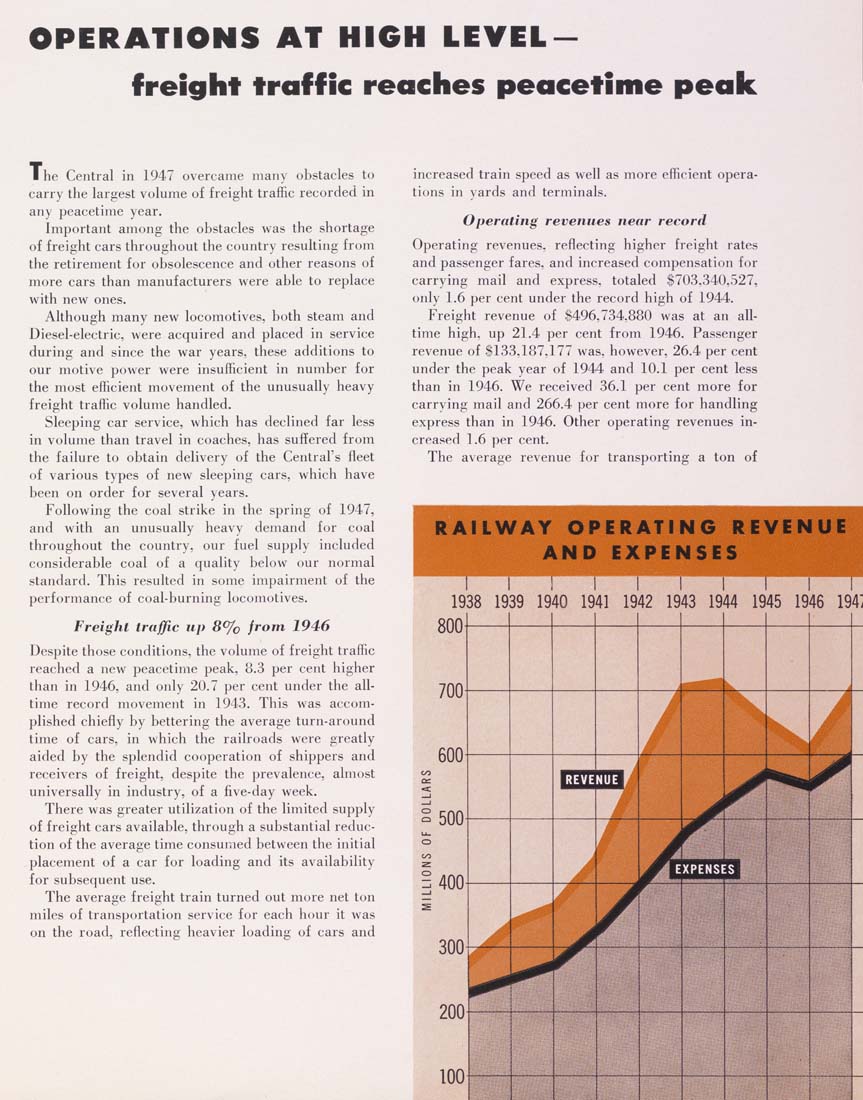OPERATIONS AT HIGH LEVEL-
freight traffic reaches peacetime peak
I he Central in 1947 overcame many obstacles to
carry the largest volume of freight traffic recorded in
any peacetime year.
Important among the obstacles was the shortage
of freight cars throughout the country resulting from
the retirement for obsolescence and other reasons of
more cars than manufacturers were able to replace
with new ones.
Although many new locomotives, both steam and
Diesel-electric, were acquired and placed in service
during and since the war years, these additions to
our motive power were insufficient in number for
the most efficient movement of the unusually heavy
freight traffic volume handled.
Sleeping car service, which has declined far less
in volume than travel in coaches, has suffered from
the failure to obtain delivery of the Central's fleet
of various types of new sleeping cars, which have
been on order for several years.
Following the coal strike in the spring of 1947,
and with an unusually heavy demand for coal
throughout the country, our fuel supply included
considerable coal of a quality below our normal
standard. This resulted in some impairment of the
performance of coal-burning locomotives.
Freight traffic up 8% from 1946
Despite those conditions, the volume of freight traffic
reached a new peacetime peak, 8.3 per cent higher
than in 1946, and only 20.7 per cent under the all-
time record movement in 1943. This was accom¬
plished chiefly by bettering the average turn-around
time of cars, in which the railroads were greatly
aided by the splendid cooperation of shippers and
receivers of freight, despite the prevalence, almost
universally in industry, of a five-day week.
There was greater utilization of the limited supply
of freight cars available, through a substantial reduc¬
tion of the average time consumed between the initial
placement of a car for loading and its availability
for subsequent use.
The average freight train turned out more net ton
miles of transportation service for each hour it was
on the road, reflecting heavier loading of cars and
increased train speed as well as more efficient opera¬
tions in yards and terminals.
Operating revenues near record
Operating revenues, reflecting higher freight rates
and passenger fares, and increased compensation for
carrying mail and express, totaled $703,340,527,
only 1.6 per cent under the record high of 1944.
Freight revenue of $496,734,880 was at an all-
time high, up 21.4 per cent from 1946. Passenger
revenue of $133,187,177 was, however, 26.4 per cent
under the peak year of 1944 and 10.1 per cent less
than in 1946. We received 36.1 per cent more for
carrying mail and 266.4 per cent more for handling
express than in 1946. Other operating revenues in¬
creased 1.6 per cent.
The average revenue for transporting a ton of
%
ILWAY OPERATING REVEN
AND EXPENSES
J
1938 1939 1940 1941 1942 1943 1944 1945 1946 194;
800
S400
|








